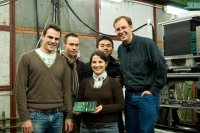 |
 |
|||||||||||||
|
|||||||||||||
|
|||||||||||||
|
Have you ever used a map to find an electron? Not possible, you say? Think again. Spell it slightly differently – MAPS – put it into an electromagnetic calorimeter, and you may well be able to track an electron in a calorimeter and see the single electrons in a particle shower. With a spatial granularity of 50 microns square– that's 50 thousandths of a millimetre – a potential sensor, called MAPS or monolithic active pixel sensor, for an ILC detector's digital electromagnetic calorimeter could be an efficient alternative to existing silicon technology. A UK-based group is currently evaluating how suitable this technology is for a calorimeter optimised for particle flow, with a view to seeing how efficient, reliable and cost-effective it is. The advantage of the MAPS sensor is that it is one piece where conventional silicon sensors for calorimeters needed two: the sensitive layers of a current silicon-based electromagnetic calorimeter and the application-specific integrated circuit for the readout. However, the readout chip must be custom-designed and needs to be bonded onto the silicon layer Whereas a conventional silicon sensor detects the particle and passes the information on to the readout chip, MAPS does both in that it combines active sensor and readout pad in one integrated piece. This one piece is also relatively easy to obtain as it made with the same transistor structure, CMOS or Complementary Metal Oxide Semiconductor, as for example standard processors on desktop computers. The sensor's design also exploits a new manufacturing capability: a layer of p-well silicon is embedded under the sensor's n-well logic. Developers think that this will substantially increase the charge collection efficiency. “We think that MAPS has a case both for the physics we are trying to achieve and for advanced technology,” says Jamie Ballin from Imperial College London, who is working on a PhD on MAPS. “We have a fantastic spatial granularity that would meet the high goals for particle flow in an ILC detector.” At the moment about a hundred of these sensors that have an active area of about nine by nine millimetres exist and have been tested at various labs in the UK. The most recent test, using an electron beam at DESY, had four boards with a sensor each were placed behind each other, interlaced with sheets of tungsten. After a week of shifts and half a million collected events, the team from Rutherford Appleton Laboratory, Imperial College and Birmingham is sifting through their results. “For us this was the first real test with beam, so we were very happy to see the sensor operating very reliably. It didn't fail once! We were able see tracks and showers passing through the sensor,” explains coordinator Marcel Stanitzki from Rutherford. “The goal of this test run were not detailed shower studies, since the active area is too small for that prototype, but to show the proof of principle.” The prototype MAPS chip is a complex device with 28000 readout channels per sensor and its own data acquisition system. The 'real' electromagnetic calorimeter would have 1012 channels - a different kind of Terascale, but one that is just as challenging. "Scary," smiles Ballin. Work is underway to design a second prototype based on results collected from the first sensor. -- Barbara Warmbein |
|||||||||||||
| © International Linear Collider |
